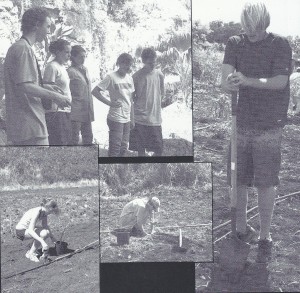Ten Years After
September 17, 2015

The 2005-2006 yearbook at Island School shows high schoolers in the Junior Restoration Team planting
some of the very first trees in the field restorations at Makauwahi Cave Reserve.
It’s hard to believe that, one decade ago, the native coastal dry woodland that folks call “Lida’s Field of Dreams” was just one of the worst thickets of invasive weeds, brush, and small non-native trees anybody’s ever seen. October 3, 2005, a group of high schoolers from nearby Island School, the Junior Restoration Team, planted the very first row of native trees on the newly-cleared field. Many years and acres later, it was an interesting successful experiment in coastal habitat restoration featuring some of Kaua`i’s rarest native trees, old Hawaiian cultivars, and a herd of giant tortoises to help do the weeding and fertilizing.
We were keenly reminded of all this recently while sifting through a decade of monitoring data on 3388 of the 80 species of native plants outplanted, for a forthcoming scientific paper on these projects and how they’ve done on a site that many experts said initially had little or no chance of success because of the worn-out agricultural soils, invasive species, and so forth. In the early years, much of our time went into “farming” native plants – without the use of agricultural chemicals — removing all the weeds and brush, tilling the soil, planting natives in rows, setting up temporary drip irrigation, weeding, weeding, weeding…
When I look around that landscape today, I see not just our best guess as to what the place approximately looked like to the first Hawaiians, but also, in my mind’s eye, the hands and faces of the perhaps 10,000 people or more – local school children, college groups, and tourists from throughout the world – who did all this loving work. Thanks to them, 17 acres of land nobody wanted anymore now has value again, any way you want to measure it.
What now? A restoration project that started with no money all those years ago still chugs along hand-to-mouth with the help of donors, grants, and the dedication of staff, volunteers, and interns. To help others do restoration, the project now has a fully-functioning nursery for native plants, Hawaiian cultivars, and the helpful tortoises. My 2010 book about the discoveries at the cave and how it led to all this, instead of disappearing on the remaindered book-shelf as I had expected, is now in its third printing at Yale University Press and widely available. Scientific papers cover more and more breakthrough topics at the site, thanks to over a dozen top-notch scientists in as many fields who have worked with us (see the cave’s website for downloadable literature on the site).
And somehow, with your help, we will replace our rotting bridge soon! Please don’t be shy – hit that PayPal button and help us build the new bridge we need to keep the Makauwahi Cave Self-guiding Nature Trail as a way for our visitors – about 30,000 last year, probably more this year – to get between the cave itself, and the “Field of Dreams” it spawned ten years ago. “If you plant them, they will grow,” somebody must have whispered…to which we would have to add “only if you care for them.”